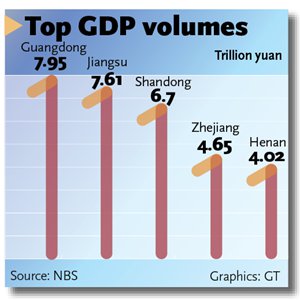
South China's Guangdong Province continued to lead the country in provincial GDP volume in 2016 as Northeast China suffered from sluggish or even negative growth, according to economic development reports filed by 31 provinces.
As China enters a "new normal" development phase, local governments are expected to attach more importance to quality over quantity, including an upgrade of traditional industries and nurturing new economic driving forces, experts said.
Official data showed nine provinces posted economic output of over 3 trillion yuan ($436 billion) in 2016. South China's Guangdong Province led the nation in GDP volume and Southwest China's Tibet Autonomous Region in GDP growth at 11.5 percent.
But Northeast China's Liaoning Province reported a -2.5 percent GDP growth last year compared to the previous year, with its economic output declining by 23.3 percent to about 2.2 trillion yuan, dropping from the 10th largest to 14th in the country.
Niu Li, director of the Macroeconomic Research Office at the State Information Center, said that Liaoning's GDP volume dropped in 2016 largely due to sluggish local economic performance.
But the focus was on the province's bogus economic data, and the local government is stepping up efforts to "squeeze the water," Niu told the Global Times on Thursday.
Liaoning Governor Chen Qiufa admitted in January that some local fiscal and economic figures between 2011 and 2014 were falsified.
Chen told a local government meeting that the province began to improve data accuracy in 2015, when revenue contracted by 33.4 percent on an annual basis, the People's Daily reported.
It's not surprising that Liaoning reported negative growth, Dong Dengxin, director of the Finance and Securities Institute at Wuhan University of Science and Technology, told the Global Times on Thursday.
"Northeastern provinces are China's heavy industry base, but local economic development was largely affected by the global economic crisis [in 2008], because the three provinces relied on past gains," Dong noted.
Experts said that China's northeastern provinces, including Heilongjiang, Liaoning and Jilin, have been "experiencing pain" during the economic transformation, as overcapacity remains, especially in key industries like coal and steel.
In a bid to save those provinces from hardship, the central and local governments should be committed to upgrading traditional industries and creating new economic drivers by nurturing rising industries, including electric vehicles, robotics, drones and big data, according to Niu.
The Liaoning government said it's planning infrastructure projects in 2017, the Chongqing Morning Post reported on Monday.
While China's northeastern provinces experienced slow economic development, economic growth in three provinces in Southwest China made strides in 2016.
Aside from Tibet's 11.5 percent GDP growth, Chongqing Municipality and Guizhou Province reported a 10.7 percent and 10.5 percent growth, respectively.
Because the three are located in China's underdeveloped western region, their economic performance looked impressive because their output bases are comparatively small, and benefitted from industries transferred from the eastern region of the country, Dong noted.
"Another reason is that the Chinese government is beefing up efforts to support some western provinces beset with poverty," he said.
Bridging the wealth gap
In a year defined by tough economic conditions and deepening supply-side reform, Guangdong's economy rose by 7.5 percent from the previous year to 7.95 trillion yuan, according to data released by the province's statistics bureau.
This is the 28th consecutive year that Guangdong's GDP volume was the largest in China, and if the province was a country, its economy would be the 15th largest in the world, just behind Mexico's economy, domestic news portal yicai.com reported Wednesday.
Guangdong is the frontier of China's reform and opening-up, which allows the province to attract production and manpower resources in the country, Dong said.
"For example, Chinese workers are more likely to go to Guangdong Province thanks to its large market," he said.
But one primary problem still exists - the imbalance between urban and rural development, Dong said, noting that a wide gap in economic growth exists between some rural areas and cities in the province.
Local authorities are expected to understate the speed and scale of economic growth, as it focuses on upgrading industries and advancing the transformation of economic development in a bid to improve the people's livelihood and guarantee their welfare, according to Dong.

















